About one-in-five adults in the U.S. today (18%) are ages 65 and older. To understand how these older Americans are aging and the factors associated with aging well, we asked them a series of questions about how things are going in their lives and how they spend their time.
These questions are part of a larger survey on aging conducted Sept. 2-8, 2025, among 8,750 U.S. adults of all ages. Read key findings from the full study.
Factors associated with older adults’ sense of aging extremely or very well include:
- Physical and mental health
- Cognitive health
- Financial security
- Social support
Some activities, such as hobbies and learning new skills, are also linked with their sense of aging well.1
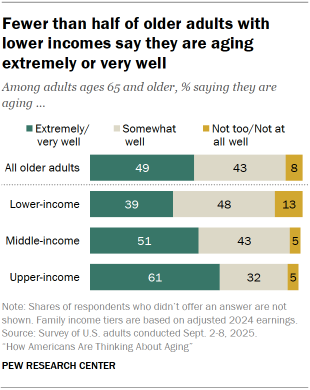
Overall, income is central to the aging experience. From how well they think they’re aging to how they rate their physical and mental health and financial security, older adults with upper incomes are doing better than those with middle or lower incomes.
There are also income differences in how adults ages 65 and older spend their time. Those with upper incomes are more likely than those with middle and lower incomes to say they often spend time pursuing hobbies and other interests or socializing with friends. They’re also more likely to be working full time.
Jump to the sections about:
- How older adults rate different aspects of their lives
- How older adults spend their time
- How income shapes the aging experience
How older adults rate different aspects of their lives
Health and mobility
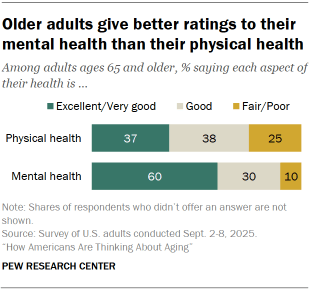
Six-in-ten adults ages 65 and older say their mental health is excellent or very good. Far fewer (37%) say the same about their physical health.
While most say they need little to no help handling their affairs or caring for themselves, 16% say they do. And about a quarter say they experience mental confusion or memory loss at least sometimes (24%) and that it’s difficult for them to carry out everyday physical activities, such as walking, climbing stairs or carrying groceries (22%).
For the most part, older adults’ ratings of their overall physical and mental health don’t differ by age, but there are age differences on self-assessments of cognitive health and physical mobility. Americans ages 80 and older are more likely than those ages 65 to 79 to say they experience mental confusion or memory loss at least sometimes (31% vs. 22%). And those ages 75 and older are more likely than those ages 65 to 74 to say they find it difficult to carry out everyday physical activities (28% vs. 18%).
Emotional well-being and social connection

Older adults generally feel positive about the emotional and social aspects of their lives. Seven-in-ten say they feel they have people they can turn to for support all or most of the time. And a similar share (65%) say they rarely or never feel lonely or isolated from those around them. Still, about a third of older adults (35%) say they do feel lonely or isolated at times, and that share is particularly high among those who live alone (51%).
On their more general outlook, 66% say they feel optimistic about their life all or most of the time. And relatively small shares (11%) frequently feel stressed or anxious, though 58% feel this way at least sometimes.
These findings don’t vary much when looking at those ages 65 to 74 versus those ages 75 and older.
Financial outlook
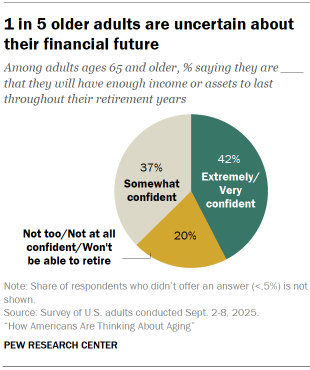
About four-in-ten Americans ages 65 and older (42%) are highly confident that they’ll have enough income and assets to last throughout their retirement years. But one-in-five express uncertainty about their financial future.
This uncertainty is most pronounced among those ages 65 to 69, about a quarter of whom (26%) are not too or not at all confident they’ll have enough money to last throughout their retirement years or say they won’t be able to retire at all. This compares with 18% of adults in their 70s and 13% of those in their 80s and older.
How older adults spend their time
Family and social life
Among older Americans with adult children, 71% say they are in touch with their adult children at least a few times a week. This includes seeing them in person, talking on the phone or texting.
Smaller shares are in contact with their grandchildren (41% among those who have grandchildren) and extended family (30% among those who have other extended family) with the same frequency.
When it comes to socializing with friends, 36% of adults ages 65 and older say they do this extremely or very often.
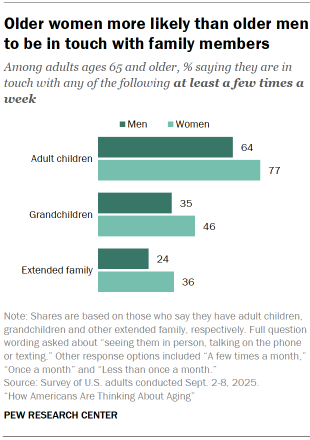
These findings differ by gender.Older women are more likely than older men to say they are in touch with each of the following at least a few times a week:
- Their adult children (77% vs. 64%)
- Their grandchildren (46% vs. 35%)
- Their extended family (36% vs. 24%)
Older women are also somewhat more likely than older men to say they socialize with their friends often (38% vs. 33%).
Hobbies and new skills
About half of Americans ages 65 and older (48%) say they spend time on hobbies and other interests extremely or very often. A smaller share (12%) say they often try learning new skills, such as speaking a new language, doing a new sport or physical activity, or using new technology; another 37% say they do this sometimes.
Community engagement
Many older adults engage in community activities. Four-in-ten say they are active members of civic groups or interest clubs, such as neighborhood associations, religious or spiritual groups, sports or recreation leagues, or book clubs.
About a third (32%) say they spend time on volunteer work at least sometimes.
Religious practices
More than half of adults ages 65 and older (56%) say they pray at least daily. And 36% attend religious services in person at least monthly.
To read about how the religious practices of older adults compare with those of younger adults, refer to Pew Research Center’s U.S. Religious Landscape Study.
Employment
About one-in-ten adults ages 65 and older (9%) say they are employed full time. Another 7% say they are working part time. Adults ages 65 to 69 are the most likely to be working: 31% in this group are employed, compared with 12% of adults in their 70s and 3% of those in their 80s and older.
Older adults who are employed are more likely than those who are not to say they feel their contributions to society at this stage of life are valued a great deal or a fair amount (47% vs. 33%). Overall, about a third of older adults (35%) feel their contributions to society are highly valued.
How income shapes the aging experience
There is a large income gap in older adults’ overall assessments of how well they’re aging. About six-in-ten of those in the upper income tier (61%) say they are aging extremely or very well. This compares with 51% among those with middle incomes and 39% among those with lower incomes.
Older adults with upper incomes also have a clear advantage on each of the key factors associated with aging well:
- Physical health: Older Americans with upper incomes are about twice as likely as those with lower incomes to say their physical health is excellent or very good (49% vs. 26%).
- Mental health: About three-quarters of older adults with upper incomes (73%) rate their mental health highly. A much smaller share of those with lower incomes (45%) do the same.
- Cognitive health: 87% of upper-income older adults say they rarely or never experience mental confusion or memory loss. This compares with 77% of those with middle incomes and 68% of those with lower incomes.
- Financial security: Those with upper incomes are more than three times as likely as those with lower incomes to feel highly confident they’ll have enough income and assets to last throughout their retirement years (72% vs. 21%).
When it comes to social support, older Americans in the middle and upper income tiers are equally likely to say they feel they have people they can turn to for support all or most of the time (75% each). A much smaller share of those with lower incomes say the same (57%).
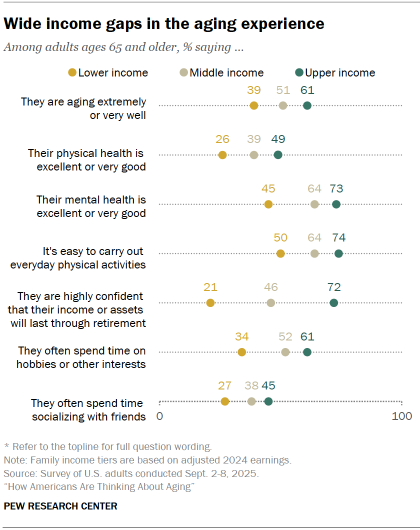
How older adults spend their time also varies widely by income. For example, those with upper incomes are more likely to be employed full time (18% vs. 10% of those with middle incomes and 6% of those with lower incomes). They are also more likely to spend time pursuing hobbies and other interests and socializing with friends.
Refer to the appendix for detailed tables showing how these responses differ by gender and age.




